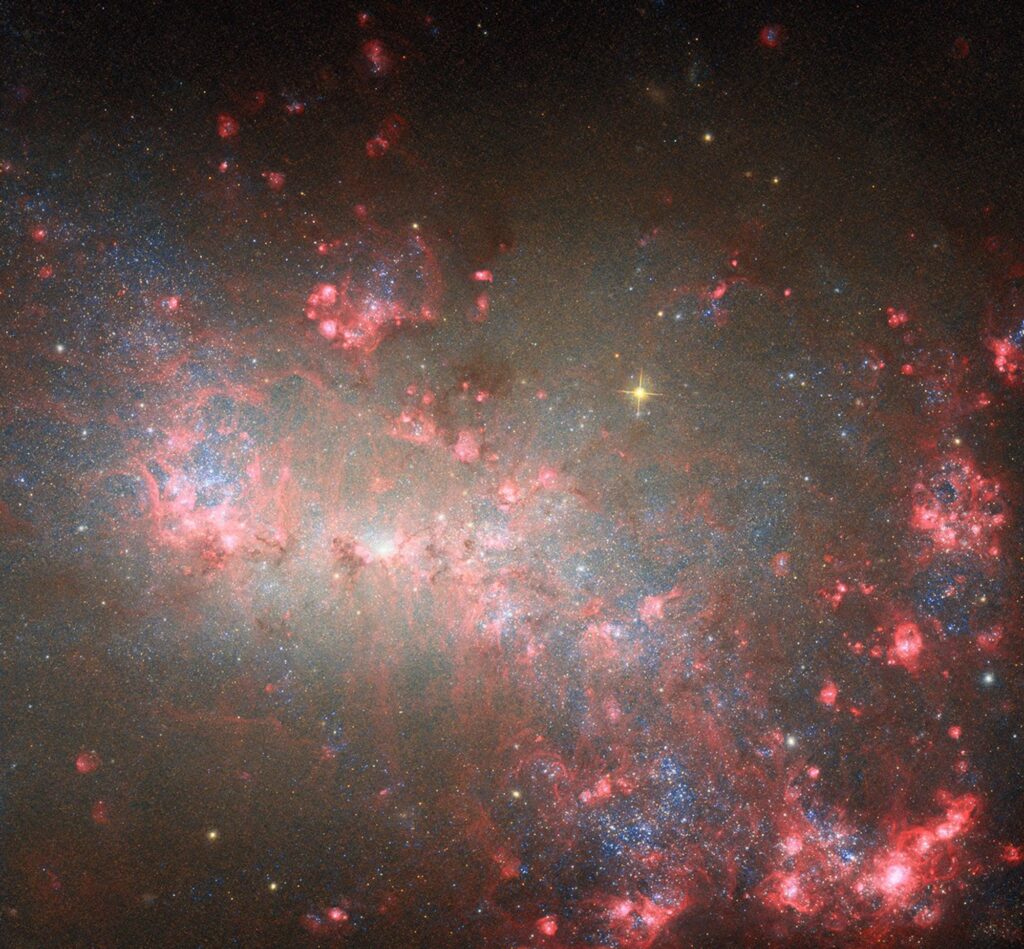Table of Contents

Introduction: Discovering the Starburst Galaxy NGC 4449
The Universe is full of surprises, and one of the most astonishing examples comes from a small, nearby galaxy with an unexpectedly powerful star-forming capability — the starburst galaxy NGC 4449. Despite its relatively small size, starburst galaxy has earned a prominent place in astronomical research due to its explosive rate of star birth. Thanks to the combined power of the NASA/ESA Hubble Space Telescope and the James Webb Space Telescope (JWST), scientists have uncovered fascinating insights into the dynamics, structure, and future of this dwarf galaxy.
Where is Starburst Galaxy NGC 4449 Located?
The starburst galaxy NGC 4449 lies just 12.5 million light-years from Earth in the constellation Canes Venatici (Latin for the Hunting Dogs). This makes it a cosmic neighbor in astronomical terms. It belongs to the M94 galaxy group, a collection of galaxies near the Local Group, which includes our Milky Way.
This proximity offers a unique opportunity: scientists can study this galaxy in greater detail than many other starburst systems, making NGC 4449 a vital case study in how galaxies evolve, form stars, and interact with their surroundings.
What Makes NGC 4449 a Starburst Galaxy?
A starburst galaxy is one undergoing an intense period of star formation—producing new stars at a rate far higher than average. While most dwarf galaxies exhibit moderate or low rates of star birth, the starburst galaxy NGC 4449 defies this trend. What makes NGC 4449 exceptional is that it is forming stars across its entire disk, not just in its central region.
This widespread star formation is thought to be triggered by interactions with nearby galaxies, which may have disturbed the galaxy’s gas and ignited a galactic-scale starburst. These interactions likely compressed the gas and dust, kickstarting the gravitational collapse that leads to star formation.
Hubble’s Deep Dive into Starburst Galaxy
The Hubble Space Telescope first captured a detailed image of NGC 4449 in 2007. That initial observation already showcased its stunning beauty, but recent updates have expanded our understanding significantly.
The newly enhanced portrait of starburst galaxy NGC 4449 includes data from multiple wavelengths gathered over several scientific campaigns. These extended observations allowed astronomers to:
- Map out hot, massive stars throughout the galaxy
- Analyze young stellar populations and their distribution
- Explore the galactic dynamics that are fueling star formation
These Hubble programs offer an unprecedented look at how small galaxies can host complex stellar ecosystems, often driven by interactions with other galaxies or internal gravitational forces.
The Role of James Webb in Exploring NGC 4449
The James Webb Space Telescope (JWST) has taken our understanding even further. Its infrared capabilities allow scientists to peer through the dust that often obscures star-forming regions in visible light. In the case of starburst galaxy, JWST reveals:
- Tendrils of dusty gas snaking through the galaxy
- Radiant star-forming regions that glow brightly in the infrared
- Evidence of recent star-forming episodes in regions previously hidden from view
JWST’s observations show how young, hot stars heat the surrounding gas, causing it to glow and outline the structures of the galaxy in unprecedented detail. This helps astronomers pinpoint exact locations of recent star formation, as well as the flow of gas and dust that fuels it.
Starburst Galaxy NGC 4449 and Galactic Interactions
One key takeaway from studying the starburst galaxy NGC 4449 is the role of galactic interactions in triggering starbursts. While NGC 4449 may look isolated at first glance, it has likely interacted or merged with smaller satellite galaxies in the past.
These gravitational encounters can:
- Disturb existing gas and dust clouds
- Create shock waves that compress interstellar material
- Cause galaxies to siphon gas from one another
- Ignite starburst phases that can last for millions of years
This makes NGC 4449 an ideal model to understand how external influences drive star formation on a galactic scale.
Scientific Impact and Broader Implications
The study of the starburst galaxy is more than a beautiful cosmic portrait — it’s a crucial piece of the puzzle in understanding galactic evolution. Here’s why it matters:
- Dwarf galaxies like NGC 4449 are common building blocks of larger galaxies.
- Their star-forming behavior offers clues to early Universe conditions, when such galaxies were more prevalent.
- The insights gained help refine models of galaxy formation, especially regarding how interactions and mergers shape structure and activity.
Furthermore, the combination of Hubble’s optical precision and JWST’s infrared capabilities gives astronomers a multi-layered view of galactic ecosystems, setting a benchmark for future studies of similar systems.
A Visual Masterpiece: The Updated Image of NGC 4449
The new image of starburst galaxy , combining data from Hubble’s multiple filters and wavelengths, is nothing short of spectacular. It shows:
- Colorful star clusters scattered throughout the galaxy
- Filaments of gas glowing due to stellar radiation
- Dark dust lanes threading across bright regions
- A diverse population of young and old stars
This image serves not only as scientific data but as a stunning visual testament to the creative forces at work in our Universe.
Conclusion: Small Galaxy, Big Story
The starburst galaxy NGC 4449 proves that even the smallest galaxies can have the biggest stories. From rapid star formation to interactions with neighboring systems, it exemplifies how dynamic and complex dwarf galaxies can be.
As telescopes like Hubble and James Webb continue to refine our view of the cosmos, galaxies like NGC 4449 will remain essential to understanding the life cycle of stars, the mechanics of galactic evolution, and the history of the Universe itself.
Whether you’re an astronomer or a curious mind looking up at the night sky, starburst galaxy offers a brilliant reminder that in the vast Universe, small doesn’t mean simple.